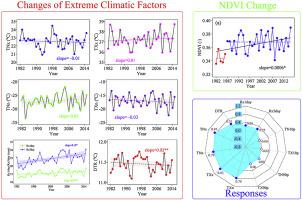Journal of Cleaner Production ( IF 11.1 ) Pub Date : 2020-06-21 , DOI: 10.1016/j.jclepro.2020.122396 Min Luo , Chula Sa , Fanhao Meng , Yongchao Duan , Tie Liu , Yuhai Bao

|
The arid and semi-arid areas of Central Asia are especially susceptible and vulnerable to climatic change, thus making understanding the relationship between extreme climate and vegetation dynamics in recent decades very important. Based on the maximum value composite, trend analysis, Mann-Kendall test, correlation analysis, and cross-correlation analysis, this study investigated the variations of extreme climatic indices and their influences on vegetation dynamics using the Unified Gauged-Based Analysis data from the NOAA Climate Prediction Center (CPC) and the Global Inventory Monitoring and Modeling Studies (GIMMS) normalized difference vegetation index (NDVI) series of 1982–2015. In general terms, it is suggested that Central Asia has experienced more extreme precipitation and high temperature events, especially in the mountainous regions. The vegetation in Central Asia has significantly increased during the past 34 years at a rate of . The NDVI is significantly and positively related to extreme precipitation and temperature intensity indices on a monthly scale, with strong spatiotemporal heterogeneity. The influences of extreme precipitation indices mainly occurred in May and June, without time lag on a monthly scale, while extreme temperatures exhibited significant relationship with maximum NDVI in April, with a time lag of at least 1 month. Analyzing the relationship between extreme climatic factors and vegetation dynamics on a monthly scale can help us to better understand the main limiting factors for vegetation growth in different growth periods compared with those on an annual scale. In the most severely affected regions, adaptation methods must be initiated, especially for improving the speed of disaster relief and reducing socioeconomic losses. The findings of this study will provide vital information for the ecological protection and sustainable development of Central Asia.
中文翻译:

每月评估一次极端气候变化及其对中亚植被的影响
中亚的干旱和半干旱地区特别容易受到气候变化的影响,因此,了解近几十年来极端气候与植被动态之间的关系非常重要。基于最大值合成,趋势分析,Mann-Kendall检验,相关分析和互相关分析,本研究使用来自NOAA的基于统一计量的分析数据,研究了极端气候指数的变化及其对植被动态的影响。气候预测中心(CPC)和全球清单监测与模型研究(GIMMS)归一化了1982-2015年间的植被指数(NDVI)系列。一般而言,建议中亚经历了更多的极端降水和高温事件,特别是在山区。。NDVI与每月的极端降水和温度强度指数显着正相关,具有强烈的时空异质性。极端降水指数的影响主要发生在5月和6月,没有月度时间滞后,而极端温度与4月的最大NDVI有显着关系,至少有1个月的时间滞后。每月分析极端气候因素与植被动态之间的关系,可以帮助我们更好地了解与年尺度相比不同生长期的植被生长的主要限制因素。在受灾最严重的地区,必须启动适应方法,尤其是为了提高救灾速度和减少社会经济损失。



























 京公网安备 11010802027423号
京公网安备 11010802027423号